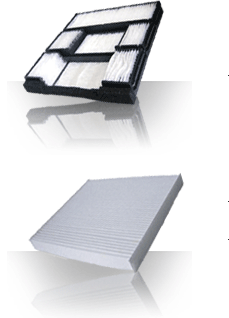|
CABIN FILTERS, ALSO CALLED |
cabin filters are used for filtering air which is sucked in directly from the road, forced in through ventilation or air conditioning system into the driver's cab. Most of the modern manufactured cars are equipped with these filters, as it is no more a synonym of luxury but the safety requirement.

Tiredness, allergic rhinitis, eye watering or breathing disorder have definitely a negative impact on the driver's reflexes and might be really dangerous for road safety. These symptoms are often cauesd by contaminants coming into the driver's cab with the air sucked. The concentration of certain types of conta-minants results from a number of actors such as season, weather conditions, noxiousness of local industuy and road traffic intensity. Air dustiness may re-ach a level six times higher than outside the car in vehicles not equipped with dust filters, as with the working ventilator, the cabin acts as a decanter. Breathing contaminated air causes negative, often an irreversible impact on the human's health. Despite natural barriers and defence mechanism, which means the ability for self-cleaning of respiratory tracks and lungs, most of the solid banks gets into the bronchial tubes or even into the pulmonary alveoluses, becoming often the source of infections. Cabin filter efficiency can be easily noticed during replacement. The surface of used filter shows exactly what it is about. Being aware that all what settles on filters might have been in our lungs should probably be the best argument for using filters in our car.
|
|
|
STANDARD CABIN FILTERS |
 Dust filters have a filtering medium made entirely from synthetic fabric. Excellent efficiency in filtering particles of sizes smaller than 1�� results from the effect of contaminants attraction by electro statically loaded fibres. Due to this effect, contaminants of sizes smaller than pores in the filtering medium maybe efficiently trapped. Smaller particles simply get stuck to fibres. Once they come close, the electrostatic attractive force is stronger than the force of particles flow caused by the air blast. Synthetic fibres are slightly hygroscopic, so dust filters do not get deformed from water. They also have antiseptic properties (they are not favourable to microorganisms), and therefore are efficient in stopping microorganisms development and organic contaminants decomposition in the filter during exploitation period. Dust filters have a filtering medium made entirely from synthetic fabric. Excellent efficiency in filtering particles of sizes smaller than 1�� results from the effect of contaminants attraction by electro statically loaded fibres. Due to this effect, contaminants of sizes smaller than pores in the filtering medium maybe efficiently trapped. Smaller particles simply get stuck to fibres. Once they come close, the electrostatic attractive force is stronger than the force of particles flow caused by the air blast. Synthetic fibres are slightly hygroscopic, so dust filters do not get deformed from water. They also have antiseptic properties (they are not favourable to microorganisms), and therefore are efficient in stopping microorganisms development and organic contaminants decomposition in the filter during exploitation period. |
|
|
CABIN FILTER WITH ACTIVE CARBON |
 Dust filters with active carbon are a special group of filters. The filtration medium consists of two outer layers made of synthetics fabric, capable of trapping solid particles and aerosols with efficiency equal to standard dust filters. Additional, third layer of filtering medium placed inside fabric layers is an active carbon granulate, which filters the air from harmful gases. The active carbon has a porousstructure similar to graphite. It attracts harmful gases to its surface due to the effect of absorption. The specific surface of one gram of active carbon comes to even 900 �� and therefore the amount of gases stopped may be significant. Practically, the amount of active carbon in filters allows eliminating about 90% of harmful gases such as ozone, hydrocarbons, sulphur and nitrogen compounds during the whole filter exploitation period. Dust filters with active carbon are a special group of filters. The filtration medium consists of two outer layers made of synthetics fabric, capable of trapping solid particles and aerosols with efficiency equal to standard dust filters. Additional, third layer of filtering medium placed inside fabric layers is an active carbon granulate, which filters the air from harmful gases. The active carbon has a porousstructure similar to graphite. It attracts harmful gases to its surface due to the effect of absorption. The specific surface of one gram of active carbon comes to even 900 �� and therefore the amount of gases stopped may be significant. Practically, the amount of active carbon in filters allows eliminating about 90% of harmful gases such as ozone, hydrocarbons, sulphur and nitrogen compounds during the whole filter exploitation period.

|
|
|
| |
|